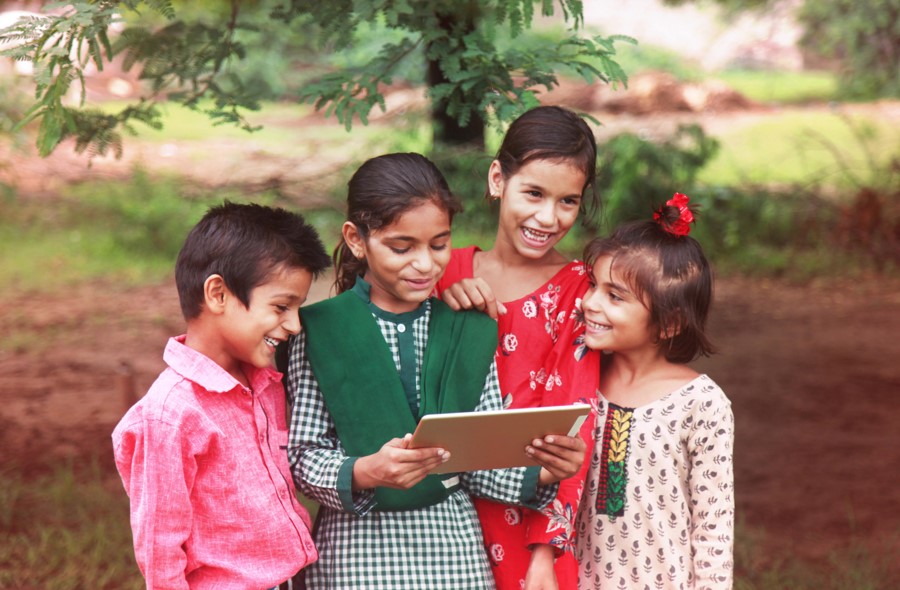
Building on evidence to shift gender attitudes among youth in India

Context
Regressive gender attitudes like son preference are prevalent across India and particularly entrenched in the state of Haryana. In 2011, the sex ratio for newborns and children up to 6 years of age in Haryana was 830 girls per 1,000 boys, reflecting sex-selective abortions. To change gender perceptions and behaviors that contribute to a preference for sons, Breakthrough, a human rights organization working to ensure dignity, equality and justice for girls and women, designed a school-based awareness and mobilization project targeted at secondary-school students and teachers in Haryana.
Implemented in 150 government schools across four districts in close partnership with the state education department, the project included training and capacity building of teachers, facilitation by staff, promotion of youth clubs called Taaron Ki Toli (cluster of stars in Hindi), media and communication campaigns and nurturing of ‘youth champions’ to further the cause of gender equality and girls’ empowerment.
Trained facilitators conducted 28 interactive classroom sessions of 45 minutes each based on the curriculum developed by Breakthrough. The curriculum covered modules on gender identity, values, aspirations, goals, roles and stereotypes, and recognition of and tolerance towards discrimination. It also included interpersonal skills, such as public speaking, communication and social interaction between the sexes, negotiation, presentation, assertiveness, leadership, self-efficacy and trust-building.
Researchers at Abdul Latif Jameel Poverty Action Lab (JPAL) South Asia, leveraging their partnership with the Haryana government’s Department of Education, worked closely with Breakthrough to assess the impact of the program on girls’ aspirations and adolescents’ gendered attitudes and behaviors.
Evidence
The mixed-methods study found that students, both adolescent boys and girls, in treatment schools were likely to have more progressive gender attitudes as measured by attitude towards girls’ opportunity for education, women’s employment outside the home, women’s role in society and fertility behavior. These impacts were not affected by parental attitudes. Although findings suggest barriers for girls to act in accordance with changed attitudes, participating boys and girls reported some more gender-equitable behavior, such as increased interaction with the opposite sex. However, the program did not affect girls’ aspirations.
Evidence impacts
Type of impact: Inform discussions of policies and programs
When subsequent phases of the evaluated programme or policy draw from the findings of the evaluation or review, and/or the study team participates in informing the design of a subsequent phase.
This is one of 3ie’s seven types of evidence use. Impact types are based on what we find in the monitoring data for an evaluation or review. Due to the nature of evidence-informed decision-making and action, 3ie looks for verifiable contributions that our evidence makes, not attribution.
Read our complete evidence impact typology and verification approach here.
Close windowBreakthrough has used evaluation findings to fine-tune current programming, while also drawing on the research team’s expertise to develop a manual to facilitate wider adoption of the model. The manual, produced by JPAL in collaboration with Breakthrough, documents and structures the facilitator-supported, school-based adolescents’ mobilization and awareness model, presenting challenges faced and lessons learnt to inform subsequent programming.
Type of impact: Inform the design of other programs
Where findings from the evaluation or review inform the design of a program(s) other than the one(s) evaluated.
This is one of 3ie’s seven types of evidence use. Impact types are based on what we find in the monitoring data for an evaluation or review. Due to the nature of evidence-informed decision-making and action, 3ie looks for verifiable contributions that our evidence makes, not attribution.
Read our complete evidence impact typology and verification approach here.
Close windowEvaluation findings have also informed a new program in the neighboring state of Punjab. In 2021, Breakthrough, the Government of Punjab’s education department and JPAL South Asia announced that they are adapting, expanding and evaluating the Taaron Ki Toli approach tested in Haryana. The approach will be part of the moral sciences, social studies and English curriculum for students in grades 6, 7 and 8 across over 4,500 government schools. Global Innovation Fund, which is funding Breakthrough for this program, cites the findings of the 3ie-supported evaluation as one of the reasons for supporting the program.
Type of impact: Inform the design of other programs
Where findings from the evaluation or review inform the design of a program(s) other than the one(s) evaluated.
This is one of 3ie’s seven types of evidence use. Impact types are based on what we find in the monitoring data for an evaluation or review. Due to the nature of evidence-informed decision-making and action, 3ie looks for verifiable contributions that our evidence makes, not attribution.
Read our complete evidence impact typology and verification approach here.
Close windowFollowing promising findings from the evaluation, the Odisha government decided to scale up the school-based gender sensitization program state-wide across 23,000 government schools and track implementation through process monitoring activities. J-PAL South Asia announced that they are "facilitating state-wide scale up" as part of the Veddis Foundation-supported ASPIRE initiative and building off an earlier 2019 partnership with the Government of Odisha.
Suggested citation
3ie, 2021. Building on evidence to shift gender attitudes among youth in India (online summary), Evidence Impact Summaries. New Delhi: International Initiative for Impact Evaluation (3ie).
Evidence impact summaries aim to demonstrate and encourage the use of evidence to inform programming and policymaking. These reflect the information available to 3ie at the time of posting. Since several factors influence policymaking, the summaries highlight contributions of evidence rather than endorsing a policy or decision or claiming that it can be attributed solely to evidence. If you have any suggestions or updates to improve this summary, please write to influence@3ieimpact.org